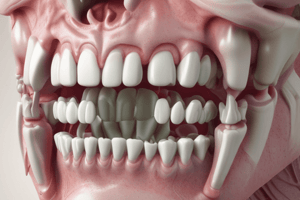Podcast
Questions and Answers
What is a distinguishing feature of the mandibular second premolar compared to the first premolar?
What is a distinguishing feature of the mandibular second premolar compared to the first premolar?
- Relatively narrow pulp chamber buccolingually
- Root and root canal cross sections are always circular
- Only one lingual pulp horn in all specimens
- The lingual pulp horn is normally smaller (correct)
In which section is the root outline described as potentially oval, rectangular, or triangular?
In which section is the root outline described as potentially oval, rectangular, or triangular?
- Mesiodistal section
- Apical third
- Cervical cross section (correct)
- Mid root cross section
How does the root and root canal cross sections of the mandibular second premolar usually appear?
How does the root and root canal cross sections of the mandibular second premolar usually appear?
- Oval or rectangular (correct)
- Triangular
- Irregularly shaped
- Round
What happens to the pulp chamber of the mandibular second premolar when compared to the first premolar?
What happens to the pulp chamber of the mandibular second premolar when compared to the first premolar?
What shape is normally associated with the canal outline in the mid root cross section?
What shape is normally associated with the canal outline in the mid root cross section?
Where is the single canal constricted to its apical termination?
Where is the single canal constricted to its apical termination?
What distinguishes some Y type specimens of the mandibular second premolar?
What distinguishes some Y type specimens of the mandibular second premolar?
Study Notes
Maxillary Premolars
- Pulp chamber of the maxillary first premolar is wider buccolingually than mesiodistally.
- Roots of the maxillary first premolar: 70% have two roots with separate foramina, and less than 10% possess a single canal.
- Buccolingual section: pulp chamber is square or rectangular with two prominent pulp horns (buccal and lingual).
- Mesiodistal section: pulp chamber is narrower than buccolingually, similar to the maxillary canine.
- Cervical cross section: root outline is wider buccolingually and kidney-shaped, with two orifices in most cases, the lingual orifice being slightly larger.
- Mid-root cross section: hour-glass appearance.
Maxillary Second Premolar
- Typically has one root and one root canal.
- Often, the canal branches in the apical third, with two foramina.
- Buccolingual section: pulp chamber has two pulp horns, with the buccal horn usually larger.
- Pulp canals: taper regularly to the apical third, where it becomes constricted.
- Foramen is normally larger than either of the foramina of the first premolar.
- Rarely, there may be two roots and two root canals, similar to the first premolar.
Mandibular Premolars
- Pulp cavity of the mandibular first premolar is wider buccolingually than mesiodistally.
- Buccolingual section: pulp chamber has two pulp horns, with a large and pointed buccal horn, and a small rounded lingual horn.
- Pulp canal: tapers rather evenly to the apical third, where it is constricted to its apical termination.
- Mesiodistal section: similar to the mandibular canine, although the canine has a longer root and pulp canal.
- Cervical cross section: both root and root canal are normally ovoid and wider buccolingually.
- Mid-root cross section: canal outline is normally round.
Mandibular Second Premolar
- Similar to the mandibular first premolar, except:
- The lingual pulp horn is normally larger.
- Some Y-type specimens exhibit two lingual pulp horns.
- The root and root canal cross sections are more often ovoid.
- The pulp chamber is relatively wider buccolingually than mesiodistally.
- The root and root canal are slightly longer.
Studying That Suits You
Use AI to generate personalized quizzes and flashcards to suit your learning preferences.
Description
Learn about the pulp cavities of maxillary premolars in dental anatomy and occlusion. Understand the features of the pulp chamber, roots, and other important aspects of these teeth.




